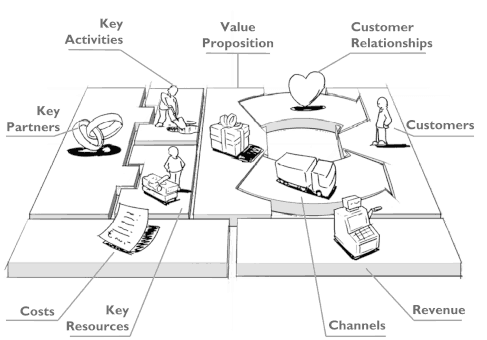What is a Business Model?
What is a business model? How can you find the right business model for your company?
Definition: A business model is the process by which the business generates or will generate profitability. It is a coherent description or representation of how to earn income from an activity.
A business model touches on the different functions of a company:
The Marketing. The business model is based on a marketing concept, that is, “creating added value to the customer”.
The organization. The economic model is based on coherent and efficient organization.
The Finances. The business model is a “revenue model” as well as a “cost model”.
Lastly, the business model is a fundamental element of a company’s strategy: it is an organizational plan that makes it possible to offer a relevant and competitive proposal, while ensuring both the company’s viability over time as well as its capacity to generate profit.
Every entrepreneur must ask himself these questions about his business model, even if it is a very small business. The entrepreneur presents his/her business model in the business plan and translates it into figures in the financial forecast.
How to identify the right business model
Finding a good business model is about finding a balance between the different constraints and opportunities that characterize the business:
- the offer that can be made keeping in mind customer expectations, organizational constraints and financial imperatives,
- the partners and external resources that can be mobilized,
- the channels of communication and distribution that can be used in light of internal or external constraints,
- the internal resources that can be mobilized: cash, productive capacities, people (skills, know-how, well-being, creativity …),
- the margins that can be achieved given the structure of variable and fixed costs.
The Business Model Canvas.
The Business Model Canvas is a well-known tool for strategic management and support for business creation. It is used to define and formalize the economic model of the company in a simple way.

Identifying the right business model involves:
1) Finding a fit between the value proposition and the target customer segment: it is necessary to conduct a market study,
2) Determine financial viability:
- initial investment not disproportionate
- return on investment fast enough
- margin on variable costs and sufficient fixed costs
- viable cash flow model (control of working capital and working capital requirements),
3) Find ways to implement the model:
- internal resources available
- call for external resources (eg outsourcing)
4) Find a sustainable model:
- the environment is taken into account (technological and regulatory developments)
- the risks are known and controlled
- the model is constantly adapted and rehabilitated
Examples of economic models.
Examples of economic models in a classical economy:
- Purchase merchandise to resell at a better price. Example: antiques dealer.
- Purchase of traded and resale items at attractive prices to generate a large volume of sales. Example: Walmart.
- Distinction by quality or image to justify a higher margin and price. Example: luxury brands.
- Choice of a very busy central location to generate volume and relativizing the level of fixed costs and rent.
- Choice of a remote but inexpensive and extensive location to offer a wider variety and lower prices than the competition.
- Choice of rare imported items to justify a high price.
- Standardize operating or production equipment to achieve large scale savings. Example: Ryanair.
- Develop optimal network coverage to become a leader. Example: Phone companies.
- Constantly innovate to stay one step ahead of competitors and build customer loyalty. Examples: Apple.
Examples of economic models in the Internet economy:
- Promote an attractive free offer to bring the customer to consume paid offers with high added value. This type of model entails a significant start-up investment (in time or money), and late incomes. Examples: Facebook, Twitter.
- Offer an attractive free website, increase the number of visitors and then monetize advertising spaces.
- Bet on advertising and notoriety and get paid commission on service rendered. Example: Booking.com.
The reasons some economic models fail.
An economic model may fail for the following reasons:
- The customer is not ready to pay the price offered
- The competition has an offer better adapted to demand and gains market share
- New start-ups appear (competitors)
- The product life cycle is running out of steam
- A technological evolution appears (new uses)
- The distribution channel is not adapted
- Return on investment too slow
- Production costs rise too fast
- The entrepreneur is too focused on maintaining his margin (regular price increase) and forgets the consumer benefit
- The investments made do not make it possible to prepare well for the future
An economic model obviously evolves. The company must adapt its model constantly, while remaining faithful to its history, its assets and its know-how.
An easy-to-use Excel financial plan frame.
WikiCrea offers you a professional and easy-to-use Excel financial plan frame: free Excel business plan template


























